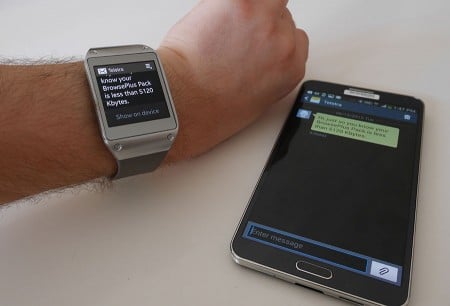While Samsung gets a lot of the smartwatch design right from the first go, there are aspects that need improvement.
One of these is the app control system, which requires you to swipe through multiple steps in order to get to the app you need.
Imagine you’re going running and you want to change the song or the volume of the track you’re listening to.
Theoretically, the Galaxy Gear makes it easy because you don’t have to pull out the phone as you’re running, and can just glance down at the watch to change tracks.

Right now, though, you have to swipe through multiple pages of shortcuts just to get to the media controller where you can change both track and volume.
App management is handled on the smartphone, which makes the most sense since you’re working on a bigger screen with more memory, but Samsung hasn’t yet made it possible for you to disable the shortcuts or apps you don’t need.
That said, we half expect Samsung to fix this with an update later down the track.
One thing that won’t be fixed with a patch, though, is the risk of condensation, which is noticeable on the Galaxy Gear’s camera when the weather starts to heat up.
Australian summers can get warm, quite warm, but we were surprised to find the Galaxy Gear sees condensation appear on the lens, thus turning every shot into a blur until it dries up.
You can’t do anything about it until the moisture dries, either, and we tried running water over the lens to fix this, but nothing worked.

Weatherproofing is one of those things watches kind of need, and we’ve heard some horror stories of smartphones taken to the snow and returning dead, so we’re a little concerned about the limits of the Galaxy Gear, and where you can travel with it. Certainly hot temperatures seem to be a problem for the camera, though the watch was fine all throughout this.
The compatibility is the other problem we’re concerned about, and at the moment, Samsung has made it a requirement of the Galaxy Gear that you use the Galaxy Note 3, which is an Android phone that runs on version 4.3, still known as “Jelly Bean.”
Support will be brought in for other Samsung devices in the near future, including the Galaxy Note 2, Galaxy S3, and Galaxy S4 smartphones, and we suspect any other Samsung product relying on a similarly upgradeable version of the Galaxy-based Android OS, such as the Galaxy S4 Active and Galaxy Mega, but basically, you have to have a Samsung phone in order to use this watch.
That might not sound like a problem, but when you’re spending over $300 on a wristwatch, it’s nice to know there’s compatibility for a device that you’ll be using for the next few years, especially when a watch should last you a minimum of between five and ten years.
Currently, smartphone owners upgrade every one to three years, and with the requirement existing that you use a Samsung smartphone, this means you’re essentially locked into using a Samsung device while you own the Galaxy Gear smartwatch.
There are many reasons why Samsung might be doing this.
It could be that it provides a better experience, or it could be that Samsung devices have a specific driver that makes the interaction happen, or it could even be that you have to use Samsung’s own apps store — Samsung Apps — in order to download the Galaxy Gear manager and the apps that connect with it, the latter of these is the more likely answer since our use of the device indicates this to be the case.
This isn’t like other smartwatches out there that don’t require a specific product.
The Pebble Smartwatch, for instance, only requires iOS or Android, so you can choose practically any device out there supporting either, and go for your life. Sony’s Smartwatch also works with a lot of Android phones, and isn’t just limited to one, two, or four devices.
Samsung’s is, though, and if you plan to stick with your Galaxy phone for a while, no worries, but not everyone can say they will, and thus if you switch, this watch could become a costly exercise.

Conclusion
In the past decade, we’ve seen more people drop the wristwatch in favour of pulling out their smartphone and using that instead as their dedicated time-keeping mechanism, and yet here we are with a product that encourages you to slap on a new wearable that does the same thing.
People who love wearing watches will likely love this product since it does what the watch already does, but also packs in notifications, phone call alerts, a pedometer, and can essentially be expanded to support more features thanks to it working with the phone.
But you’ll need to use a very recent Samsung phone if you want this, and you’ll need to keep using it, because right now, that’s the requirement.
If you can live with that, the Galaxy Gear is neat first-generation product to help you take the future with you in your travels. If you can’t, it might be best to wait for a more compatible companion device, because this isn’t the first, and it certainly won’t be the last.












































One Comment